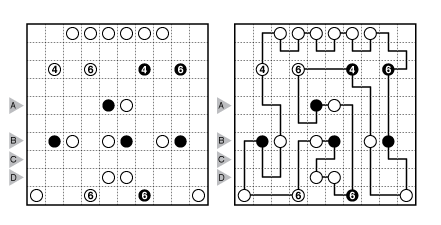Balance Loop Rules and Info

Rules: Draw a single, non-intersecting loop that passes through all cells with circles; the loop may either go straight through or turn at each circle. All white circles must have loop segments of equal length extending from both sides of the circle before turning. All black circles must have loop segments of unequal length extending from both sides of the circle before turning. Numbers, where given, indicate the sum of the loop segment lengths on both sides of the circle. (Note that the total counts are not affected by other circles being crossed before turning.)
Answer String: Enter the length in cells of the horizontal loop segments from left to right in the marked rows, starting at the top. If the loop only has vertical segments in the marked row, enter 0. Separate each row’s entry with a comma. This example has the key “12,12,11,11”.
(Brief) History of Balance Loop: Balance Loop was created by Prasanna Seshadri and debuted in 2015 on Grandmaster Puzzles. The style arose from trying to bring length clues (such as in Cave or Four Winds) to loop puzzles. Besides the numeric clues, a critical addition to the rules was the concept of “balance” with colored circles indicating equal versus unequal splits of the segments extending from a given cell. The graphical style was inspired by Masyu, which also uses white and black circles to denote cells with somewhat opposite rules.
History of this example: This Balance Loop was written by Prasanna Seshadri for the 2015 Indian Puzzle Championship.
Sources for Balance Loop puzzles: Follow this link for classic Balance Loop puzzles on this website and this link for variations on Balance Loop puzzles. If you are new to this puzzle type, here are our easiest Balance Loop puzzles to get started on. More Balance Loops can be found in our beginner-friendly collection Intro to GMPuzzles by Serkan Yürekli and in Balance Loop by Prasanna Seshadri and Murat Can Tonta.
Design rules for contributors: A Grandmaster Balance Loop will have a unique solution that can be reached by logic alone. Generally, a Grandmaster Balance Loop should have some aspects of symmetry, or a theme that is interesting enough to not require symmetry. Sizes from 8×8 and above are recommended (maximum aspect ratio of 2:1 if rectangular).

Your posted solution here seems slightly incorrect. I think the black 6 at R3C9 should go straight north/south; its segments only sum to 5 in the posted solution.
The distance counted is to the next turn of the loop (not affected by crossing other circles) so there are five vertical and one horizontal segments for R3C9 = 5+1 = 6. I added a small note to the rules to clarify this but the example is correct.